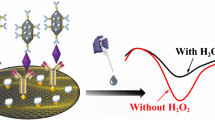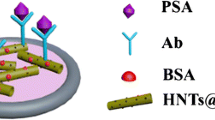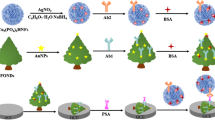Abstract
A dual enhancing strategy has been employed to develop a sandwich type of electrochemical immunoassay for the prostate specific antigen (PSA). The signal is enhanced by using Pt-Cu hierarchical trigonal bipyramid nanoframes (HTBNFs) and a composite consisting of Fe3O4 nanoparticles and reduced graphene oxide in polydopamine that serve to capture the primary antibody (Ab1). This nanocomposite shows better electrical conductivity than Fe3O4 and reduced graphene oxide (RGO), respectively, alone. The Pt-Cu HTBNFs were used to label the secondary antibody (Ab2) and act as tags for signal amplification by virtue of their outstanding electrochemical reduction activity towards H2O2. At a working potential of +0.1 V (vs. SCE), the interference by dissolved oxygen can be avoided. This immunoassay is highly sensitive, with a linear range that extends from 0.1 pg⋅mL−1 to 5 ng⋅mL−1 and an ultralow detection limit of 0.03 pg⋅mL−1.

Schematic of the dual amplification strategy in the immunosensor for the prostate specific antigen (PSA) that is based on the use of a first antibody (Ab1) conjugated to a Fe3O4-reduced graphene oxide nanocomposite (Fe3O4-RGO), and of Pt-Cu trigonal bipyramid nanoframes as a label for the second antibody (Ab2).





Similar content being viewed by others
References
Uludag Y, Köktürk G (2015) Determination of prostate-specific antigen in serum samples using gold nanoparticle based amplification and lab-on-a-chip based amperometric detection. Microchim Acta 182(9–10):1685–1691
Yang J, Wen W, Zhang X, Wang S (2015) Electrochemical immunoassay for the prostate specific antigen detection based on carbon nanotube and gold nanoparticle amplification strategy. Microchim Acta 182(9):1855–1861
Xu H, Xu Y, Luo X (2015) Peptide-based biosensor for the prostate-specific antigen using magnetic particle-bound invertase and a personal glucose meter for readout. Microchim Acta 182(9–10):93–94
Wang Y, Qu Y, Liu G, Hou X, Huang Y, Wu W, Wu K, Li C (2015) Electrochemical immunoassay for the prostate specific antigen using a reduced graphene oxide functionalized with a high molecular-weight silk peptide. Microchim Acta 182(11–12):2061–2067
Peng J, Zhu YD, Li XH, Jiang LP, Abdel-Halim ES, Zhu JJ (2014) Electrochemical immunoassay for the prostate specific antigen using ceria mesoporous nanospheres. Microchim Acta 181(13–14):1505–1512
Sloan JH, Ackermann BJ, O’Dell M, Bowsher RR, Dean RA, Konrad RJ (2011) Development of a novel radioimmunoassay to detect autoantibodies to amyloid beta peptides in the presence of a cross-reactive therapeutic antibody. J Pharm Biomed Anal 56(5):1029–1034
Werner MT, Faeste CK, Egaas E (2007) Quantitative sandwich ELISA for the determination of tropomyosin from crustaceans in foods. J Agric Food Chem 55(20):8025–8032
Zong C, Wu J, Liu M, Yang L, Liu L, Yan F, Ju H (2014) Proximity hybridization-triggered signal switch for homogeneous chemiluminescent bioanalysis. Anal Chem 86(11):5573–5578
Ahn J, Shin YB, Lee JJ, Kim MG (2015) Human alpha-fetal protein immunoassay using fluorescence suppression with fluorescent-bead/antibody conjugate and enzymatic reaction. Biosens Bioelectron 71:115–120
Wei Y, Yan L, Li N, Zhang Y, Yan T, Ma H, Wei Q (2015) Sandwich-type electrochemical immunoassay for the detection of AFP based on Pd octahedral and APTES-M-CeO2-GS as signal labels. Biosens Bioelectron 79:482–487
Dutta G, Park S, Singh A, Seo J, Kim S, Yang H, Chem A (2015) Low-Interference Washing-Free Electrochemical immunoassay Using Glycerol-3-phosphate Dehydrogenase as an Enzyme Label. Anal Chem 87(7):3574–3578
Yan Z, Zheng Y, Kong R, Lian X, Qu F (2016) Ultrasensitive electrochemical immunoassay based on horseradish peroxidase (HRP)-loaded silica-poly(acrylic acid) brushes for protein biomarker detection. Biosens Bioelectron 75:383–388
Liu Y, Wang H, Xiong C, Yuan Y, Chai Y, Yuan R (2016) A sensitive electrochemiluminescence immunosensor based on luminophore capped Pd@Au core-shell nanoparticles as signal tracers and ferrocenyl compounds as signal enhancers. Biosens Bioelectron 81:334–340
Feng T, Qiao X, Wang H, Zhao S, Hong C (2015) A sandwich-type electrochemical immunoassay for carcinoembryonic antigen based on signal amplification strategy of optimized ferrocene functionalized Fe3O4@SiO2 as labels. Radiat Phys Chem 50(4):24–30
Lai G, Jie W, Ju H, Feng Y (2011) Streptavidin-Functionalized Silver-Nanoparticle-Enriched Carbon Nanotube Tag for Ultrasensitive Multiplexed Detection of Tumor Markers. Adv Funct Mater 21(15):2938–2943
Lai G, Zhang H, Tamanna T, Yu A (2014) Ultrasensitive immunoassay based on electrochemical measurement of enzymatically produced polyaniline. Anal Chem 86(3):1789–1793
Marcano DC, Kosynkin DV, Berlin JM, Sinitskii A, Sun Z, Slesarev A, Alemany LB, Lu W, Tour JM (2010) Improved synthesis of graphene oxide. ACS Nano 4(8):4806–4814
Bharath G, Madhu R, Chen SM, Veeramani V, Mangalaraj D, Ponpandian N (2015) Solvent-free mechanochemical synthesis of graphene oxide and Fe3O4–reduced graphene oxide nanocomposites for sensitive detection of nitrite. J Mater Chem A 3(30):15529–15539
Li H, Wei Q, Wang G, Yang M, Qu F, Qian Z (2011) Electrochemical immunoassays for cancer biomarker with signal amplification based on ferrocene functionalized iron oxide nanoparticles. Biosens Bioelectron 26(8):3590–3595
An P, Zuo F, Wu YP, Zhang JH, Zheng ZH, Ding XB, Peng YX (2012) Fast synthesis of dopamine-coated Fe3O4 nanoparticles through ligand-exchange method. Chin Chem Lett 23(9):1099–1102
Chen S, Su H, Wang Y, Wu W, Zeng J (2014) Size-Controlled Synthesis of Platinum–Copper Hierarchical Trigonal Bipyramid Nanoframes. Angew Chem Int Ed 127(1):110–115
Wei Q, Zhao Y, Du B, Wu D, Cai Y, Mao K, Li H, Xu C (2011) Nanoporous PtRu Alloy Enhanced Nonenzymatic Immunosensor for Ultrasensitive Detection of Microcystin-LR. Adv Funct Mater 21(21):4193–4198
Shen J, Hu Y, Shi M, Lu X, Qin C, Li C, Ye M (2009) Fast and Facile Preparation of Graphene Oxide and Reduced Graphene Oxide Nanoplatelets. Chem Mater 21(15):3514–3520
Liu Y, Ma H, Gao J, Wu D, Ren X, Yan T, Pang X, Wei Q (2016) Ultrasensitive electrochemical immunoassay for SCCA detection based on ternary Pt/PdCu nanocube anchored on three-dimensional graphene framework for signal amplification. Biosens Bioelectron 79:71–78
Acknowledgements
This work was partially supported by the National Natural Science Foundation of China (no. 21245007 and 81000976).
Author information
Authors and Affiliations
Corresponding author
Ethics declarations
The author(s) declare that they have no competing interests.
Additional information
Lei Jiao and Zonggang Mu contributed equally as co-first author.
Electronic supplementary material
ESM 1
(DOCX 153 mb)
Rights and permissions
About this article
Cite this article
Jiao, L., Mu, Z., Miao, L. et al. Enhanced amperometric immunoassay for the prostate specific antigen using Pt-Cu hierarchical trigonal bipyramid nanoframes as a label. Microchim Acta 184, 423–429 (2017). https://doi.org/10.1007/s00604-016-2023-0
Received:
Accepted:
Published:
Issue Date:
DOI: https://doi.org/10.1007/s00604-016-2023-0




